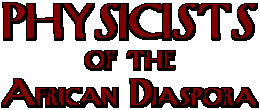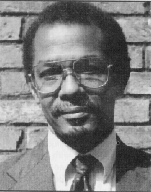

Demetrius D. Venable

born:
place:
![]() B.S. (1970) Virginia
State University; M.S. American University 1972
B.S. (1970) Virginia
State University; M.S. American University 1972
![]() Ph.D., American
University 1974. Optical physics
Ph.D., American
University 1974. Optical physics
![]() Professor of Physics
and Chairman of the Department of Physics and Astronomy at Howard
University
Professor of Physics
and Chairman of the Department of Physics and Astronomy at Howard
University
URL: http://www.physics1.howard.edu/demetrius/ddv_sketch.html
email:
Demetrius D. Venable has been Chair since July 1, 1995. From December 1999 to July 2000, he served as the Interim Associate Provost for Research. Prior to coming to Howard, Dr. Venable had held positions at IBM as a senior associate engineer, at Saint Paul's College as an Assistant Professor of Physics and Director of the Cooperative Physics Program and at Hampton University where he held various administrative positions including Department Chairman, Dean of the Graduate College, Vice President for Research, and Executive Vice President and Provost.
Dr. Venable's awards have included the American Association of Physics Teacher's Distinguished Service Citation for contributions to teaching in physics and NASA's Distinguished Public Service Medal for contributions to research infrastructure building. This latter award is the highest award that NASA can make to a non-government employee.
He is noted for work in establishing degree programs in physics and engineering and research programs in optical physics. He has served on various boards and committees at the state and national levels including membership on the U. S. Department of Energy's Fusion Energy Advisory Committee. He has held position of leadership in The American Association of Physics Teachers, The Virginia Academy of Science, The Southeastern Universities Research Association, The Virginia Aerospace Business Roundtable, and The National Physical Sciences Consortium. He is also a Charter Fellow of the National Society of Black Physicists, and is the recipient of The White House Initiative Science and Technology Advisory Committee's Faculty Award for Excellence in Science and Technology, received the G. Robert Cotton Distinguished Professorship, received the Christian R. and Mary F. Lindback Distinguished Teaching Award.
Dr. Venable's research specialty is in optical physics. He has been awarded funding for more than 20 projects and has had numerous publications and presentations at professional meetings. His research has involved theoretical radiative transfer modeling with application for remote sensing and laser systems. His works have included effects of multiple scattering in marine environments, insolation and turbidity measurements, and remote sensing of laser induced fluorescence. He has also done considerable work on laser systems development, particularly the utilization of plasma pinch devices as broadband laser pump sources in the blue-green to near ultra-violet regions of the electromagnetic spectrum. His work in this area has included studies of the optical characteristics of the plasmas produced in these devices. He has also conducted research on the 1.06 micron laser radiation damage to retinal tissue. This work involved the determination of the laser damage threshold for retinal tissue when picosecond laser pulses are used. He is currently working on problems involving remote sensing of the atmosphere using lidar.
RESEARCH
Selected Publications
Dr. Venable is a Charter Fellow of the National Society of Black Physicists, and served on the Board of Directors for the organization from 1998-2000. He has been recognized in Who's Who in the Science and Engineering, is the recipient of The White House Initiative Science and Technology Advisory Committee's Faculty Award for Excellence in Science and Technology, has received the G. Robert Cotton Distinguished Professorship, has received the Christian R. and Mary F. Lindback Distinguished Teaching Award, and was recognized in Outstanding Young Men of America. Dr. Venable serves as the Chairman of the American Institute of Physics' Advisory Committee on Education.
He has recently served as Co-Principal Investigator on the grant - "Howard University Minority Graduate Education Program"; funded by the National Science Foundation (1998-2002) and as Co-Principal Investigator on the grant -
"Modernization of Experimental Physics Course", funded by the National Science Foundation (8/1998-7/01)
Dr. Venable's research specialty is in optical physics. He has been awarded funding for more than 20 projects and has had more than 50 professional publications or presentations at professional meetings. His research has involved radiative transfer modeling and remote sensing techniques. His works have included effects of multiple scattering in marine environments, insolation and turbidity measurements, and remote sensing of the atmosphere. He has also done considerable work on laser systems development, particularly the utilization of plasma pinch devices as broadband laser pump sources in the blue-green to near ultra-violet regions of the electromagnetic spectrum. His work in this area has included studies of the optical characteristics of the plasmas produced in these devices. He is currently involved in a project to develop novel techniques for use of ground based lidar to simultaneously measure daytime lower tropospheric ozone and water vapor.
VISITORS
since opening 5/27/1997
![]()
| This website was created by and is
maintained by Dr. Scott Williams, Professor of Mathematics State University of New York at Buffalo |
SEARCH the site |
|
|
![]() 1/3/99
1/3/99